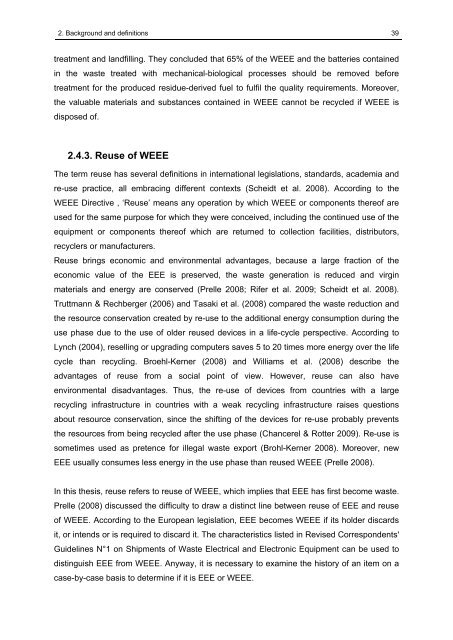SUbstance flow analysis of the recycling of small waste electrical ...
SUbstance flow analysis of the recycling of small waste electrical ...
SUbstance flow analysis of the recycling of small waste electrical ...
Create successful ePaper yourself
Turn your PDF publications into a flip-book with our unique Google optimized e-Paper software.
2. Background and definitions 39<br />
treatment and landfilling. They concluded that 65% <strong>of</strong> <strong>the</strong> WEEE and <strong>the</strong> batteries contained<br />
in <strong>the</strong> <strong>waste</strong> treated with mechanical-biological processes should be removed before<br />
treatment for <strong>the</strong> produced residue-derived fuel to fulfil <strong>the</strong> quality requirements. Moreover,<br />
<strong>the</strong> valuable materials and substances contained in WEEE cannot be recycled if WEEE is<br />
disposed <strong>of</strong>.<br />
2.4.3. Reuse <strong>of</strong> WEEE<br />
The term reuse has several definitions in international legislations, standards, academia and<br />
re-use practice, all embracing different contexts (Scheidt et al. 2008). According to <strong>the</strong><br />
WEEE Directive , ‘Reuse’ means any operation by which WEEE or components <strong>the</strong>re<strong>of</strong> are<br />
used for <strong>the</strong> same purpose for which <strong>the</strong>y were conceived, including <strong>the</strong> continued use <strong>of</strong> <strong>the</strong><br />
equipment or components <strong>the</strong>re<strong>of</strong> which are returned to collection facilities, distributors,<br />
recyclers or manufacturers.<br />
Reuse brings economic and environmental advantages, because a large fraction <strong>of</strong> <strong>the</strong><br />
economic value <strong>of</strong> <strong>the</strong> EEE is preserved, <strong>the</strong> <strong>waste</strong> generation is reduced and virgin<br />
materials and energy are conserved (Prelle 2008; Rifer et al. 2009; Scheidt et al. 2008).<br />
Truttmann & Rechberger (2006) and Tasaki et al. (2008) compared <strong>the</strong> <strong>waste</strong> reduction and<br />
<strong>the</strong> resource conservation created by re-use to <strong>the</strong> additional energy consumption during <strong>the</strong><br />
use phase due to <strong>the</strong> use <strong>of</strong> older reused devices in a life-cycle perspective. According to<br />
Lynch (2004), reselling or upgrading computers saves 5 to 20 times more energy over <strong>the</strong> life<br />
cycle than <strong>recycling</strong>. Broehl-Kerner (2008) and Williams et al. (2008) describe <strong>the</strong><br />
advantages <strong>of</strong> reuse from a social point <strong>of</strong> view. However, reuse can also have<br />
environmental disadvantages. Thus, <strong>the</strong> re-use <strong>of</strong> devices from countries with a large<br />
<strong>recycling</strong> infrastructure in countries with a weak <strong>recycling</strong> infrastructure raises questions<br />
about resource conservation, since <strong>the</strong> shifting <strong>of</strong> <strong>the</strong> devices for re-use probably prevents<br />
<strong>the</strong> resources from being recycled after <strong>the</strong> use phase (Chancerel & Rotter 2009). Re-use is<br />
sometimes used as pretence for illegal <strong>waste</strong> export (Brohl-Kerner 2008). Moreover, new<br />
EEE usually consumes less energy in <strong>the</strong> use phase than reused WEEE (Prelle 2008).<br />
In this <strong>the</strong>sis, reuse refers to reuse <strong>of</strong> WEEE, which implies that EEE has first become <strong>waste</strong>.<br />
Prelle (2008) discussed <strong>the</strong> difficulty to draw a distinct line between reuse <strong>of</strong> EEE and reuse<br />
<strong>of</strong> WEEE. According to <strong>the</strong> European legislation, EEE becomes WEEE if its holder discards<br />
it, or intends or is required to discard it. The characteristics listed in Revised Correspondents'<br />
Guidelines N°1 on Shipments <strong>of</strong> Waste Electrical and Electronic Equipment can be used to<br />
distinguish EEE from WEEE. Anyway, it is necessary to examine <strong>the</strong> history <strong>of</strong> an item on a<br />
case-by-case basis to determine if it is EEE or WEEE.

















